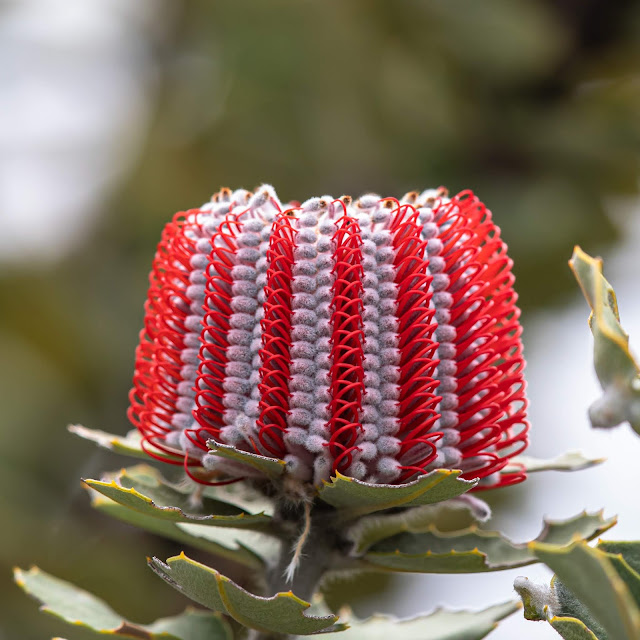Fitzgerald River National Park - Hammersley Inlet Campground
16 – 18 November 2018
Our next destination was Fitzgerald River National Park. There are several sections and campgrounds but we were headed to the eastern section, requiring a drive back up to the highway and through several towns. We stopped for coffee and shopping at Jerramungup. While there we had a quick look at the Biosphere Gardens. I say quick because it has to be the smallest botanic garden we have ever visited. The weather forecast was for storms and we drove through increasingly heavy rain on the way to Ravensthorpe. By the time we arrived it was raining heavily and there was lightning around so we decided on lunch at a café – it was impossible weather for our customary picnic lunch. Continuing on towards Hopetoun, then turning off to the National Park we saw clearer skies.
Visitors to Fitzgerald River
National Park are required to pay a park entry fee, but we had our Holiday Pass
which was still valid so we didn’t need to do this. From the entrance station
we drove through forests of banksias and hakeas on the way to Hammersley Inlet.
Along the way we passed turnoffs to a number of lookouts, beaches and walks.
Arriving at the campground we settled on a site which allowed us to face the
camper trailer towards some bush. This campground, although within the national
park, is run by Ravensthorpe Council so the fees are lower than national park
camp fees at $10 per vehicle per night. Great value for a campground with clean
toilets and a barbecue shelter. There is no drinking water so it is important
to bring your own.
 |
| White-browed Scrubwren. There weren't many birds around the campground. |
 |
| Western Thornbill |
We went for a walk down to the
inlet and were a little disappointed with the location of the campground in
proximity to the water, as well as the lack of walks and amount of cleared
bush. Grey skies didn’t help either. Camping here does allow access to lots of
other lovely spots as we found out the next day when we went for a drive.
 |
| A Western Fieldwren seen on one of the lookout walks. |
 |
| Western Fieldwren |
 |
| A great view of the inlet and Four Mile Campground. |
 |
| A local skink. |
In the morning we chatted with a
fellow camper and of course the conversation turned to birds, specifically the ones Mick
was chasing. As luck would have it, she told us about Mason Bay campground
where she had seen and heard lots of birds, including wattlebirds. Mick played
the call for the Western wattlebird, one that he had been trying to find throughout
south-west WA. She was absolutely certain that was the one she had heard, so we
added Mason Bay as our next stop.
Mason Bay
18 – 20 November 2018
Mason Bay is only a short drive
from Hopetoun so we headed there for a coffee and a look around once we had
left the national park. We then travelled on the unsealed road to Mason Bay and
the council-run campground right on the beach. Being a Sunday, and still quite
early (well before lunch time) there we lots of people there but we found a spot
in a section where there was no-one else camped. Our spot was very sheltered
from the wind, but still only a very short walk to the beach.
As we were setting up, Mick
spotted the Western Wattlebird in a tree right by our campsite. What luck!
Setting up camp was interrupted while he tried to take photos.
 |
| 'What are you looking at?' This Tawny Frogmouth was opposite our camp and wasn't happy about the sun waking it up. |
 |
| Much more serene later in the afternoon. |
 |
| A long awaited Western Wattlebird. |
 |
| Grey Fantail |
 |
| New Holland Honeyeaters holding hands. |
We spent two nights there,
and once again packed up camp in between showers of rain. After a couple of
days of milder temperatures, it was back to cold again. We keep waiting for
spring to arrive, even though it was only two weeks until the start of summer.
Back on the road with no firm
destination this time, just a plan to look at a couple of places then make up
our minds when we'd had a good look around.
Munglinup Beach
20 -21 November
We had a bit of a plan – have a
look at Munglinup Beach, then Stokes Inlet then Esperance. We’d stay at the
first place we liked the look of. First stop was Munglinup Beach. We drove past
the caravan park down to the beach where there is a day use area and a council
run camping area. Although it might have been nice camping by the beach, we
decided that a night in a caravan park was needed after four nights in
campgrounds without showers. It would also allow us to charge up batteries and
ride out some more rain in a nice camp kitchen.
 |
| This Spotted-thighed Frog made its home in the camp kitchen. |
Arriving just after 10:00 am we
decided on only one night. With more wind and rain we settled in and made use of the great camp kitchen, chatting to other travellers and even getting to watch TV for a while. All in all, it was a restful day in a nice spot.
Once again there were clouds in the sky and showers around as we packed up to head in to Esperance, or maybe Stokes Inlet.












































































